Dehumidifier Market Research, 2032
The global dehumidifier market was valued at $2.5 billion in 2022, and is projected to reach $4.7 billion by 2032, growing at a CAGR of 6.6% from 2023 to 2032.
Dehumidifier is a household appliance designed to reduce and control the humidity levels in indoor spaces. It works by removing excess moisture from the air and helps to maintain a comfortable and healthy living environment. Dehumidifiers are commonly used in areas with high humidity or moisture-related issues. It accomplishes this through methods like refrigeration or desiccant technology, condensing or absorbing water vapor, which is then collected in a removable tank or drained directly. Moreover, dehumidifiers offer a range of benefits such as it prevents issues such as mold, mildew, musty odors, and moisture damage to property. They are available in various types, sizes, and with features such as adjustable humidity settings and smart technology. In addition, they are highly purchased in regions with high humidity levels, including basements, bathrooms, and kitchens. Thus, dehumidifier plays a crucial role in maintaining a healthy & comfortable living environment. Moreover, it is used to improve indoor air quality, reduce allergens & dust mites, and enhance overall comfort by the elimination of the sticky feeling associated with excess humidity.
MARKET DYNAMICS
Globally, the need for dehumidifiers has expanded, thus the Dehumidifier Market Size. The market for dehumidifiers has been driven in large part by rise in concern about indoor air quality. Increase in indoor air pollution has resulted in a number of health problems such as allergies and respiratory disorders. Furthermore, a high relative humidity has aided in the growth of mold and mildew, aggravating existing issues. To enhance indoor air quality, the consumer spending on dehumidifiers has increased as a result of rise in awareness of the value of preserving ideal indoor humidity levels. The popularity of dehumidifiers has increased in recent years, due to their capacity to address problems brought on by high humidity, such as the growth of mold and the spread of allergens. In addition, it improves the quality of indoor air for breathing and is helpful for those with respiratory disorders. Dehumidifier adoption has increased due to the growing emphasis on energy saving, increased comfort, and a more comfortable living environment. The industry is growing as a result of manufacturers creating a wide range of dehumidifier models to meet different consumer needs, while regulations and awareness efforts have further solidified the importance of dehumidifiers in ensuring outstanding indoor air quality.
Moreover, extreme weather occurrences such as flooding and heavy rain, have increased due to regular changes in the environment. Weather occurrences have raised the humidity levels in houses and other structures which has increased demand for dehumidifiers and have increased the Dehumidifier Market Share. Furthermore, increased global temperatures have caused high humidity spells to occur more frequently and last longer in different parts of the world. Owing to these qualities, dehumidifiers are now a great way to preserve comfort and shield belongings from moisture-related harm. The need for dehumidifiers has increased as these incidents have gotten more frequent. Since dehumidifiers are necessary to handle the growing difficulties related to moisture, sales of these units have surged. In addition, in response to these climate-related issues, dehumidifiers have emerged as a vital instrument for reducing the negative impacts of extreme weather and climate change. Consequently, it has driven the dehumidifier market expansion.
However, the purchase of dehumidifiers is costly, particularly if customers seek specialized or high-capacity units. It greatly differs in price and comes in a range of sizes and capacities. Moreover, dehumidifiers intended for commercial or industrial usage tend to be more expensive due to their higher quality and capacity. Many potential consumers are put off by the initial expense, particularly home users or small businesses with tight budgets. Dehumidifiers need energy to extract moisture from the air. Over time, the continual running costs of the dehumidifier accumulate, especially in areas with high humidity levels where it must work nonstop. Dehumidifier adoption has been significantly hampered by consumers' growing concerns about the effect on their energy expenditures, which has affected the Dehumidifier Market Demand.
Electricity is needed to run the dehumidifiers and the amount of energy used varies according to the kind & size of the device. The continuous running of dehumidifiers uses more electricity especially in areas with high humidity. Further, increase in reliance on fossil fuels for electricity generation which is driven by rise in energy demands has resulted in a notable increase in greenhouse gas emissions. The dehumidifiers which utilize refrigeration-based technologies are not good for the environment. As they rely on hydrochlorofluorocarbons (HCFCs) and other harmful refrigerants, to extract moisture from the air. Furthermore, dehumidifiers include hazardous materials which include refrigerants and electrical components. As a result, the improper disposal of these equipment at the end of their life cycle poses a risk to the environment.
The market for smart and energy-efficient dehumidifiers has expanded as a result of technological improvements. These units can be connected into smart home systems, managed remotely via smartphone apps, and optimized for energy efficiency. Further, convenience & effectiveness are the factors driving the dehumidifier market growth. Moreover, as energy-efficient dehumidifiers can save running costs and carbon footprints, they are in high demand as consumers & companies become more conscious of their energy usage. With their remote monitoring and control capabilities, smart dehumidifiers provide ease of use and instantaneous control over interior humidity levels via web interfaces and smartphone apps. Furthermore, these gadgets are easily incorporated into larger smart home networks, improving the overall control of interior climate.
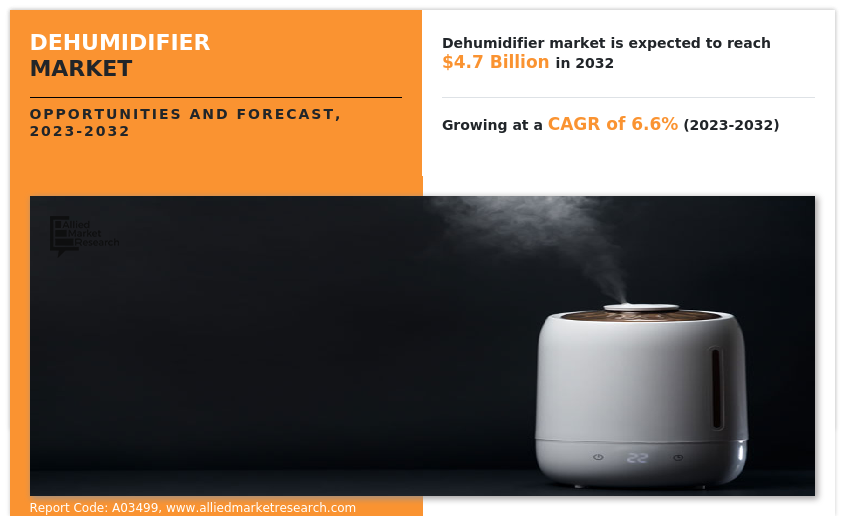
The dehumidifier market is segmented into Product, Distribution Channel and Application.
SEGMENTAL OVERVIEW
The dehumidifier market is analyzed on the basis of product, application, distribution channel, and region. On the basis of product, it is categorized into portable and fixed. By application, it is divided into residential, commercial, and industrial. As per distribution channel, it is bifurcated into online and offline. Depending on region, it is analyzed across North America, Europe, Asia-Pacific, and LAMEA.
BY PRODUCT
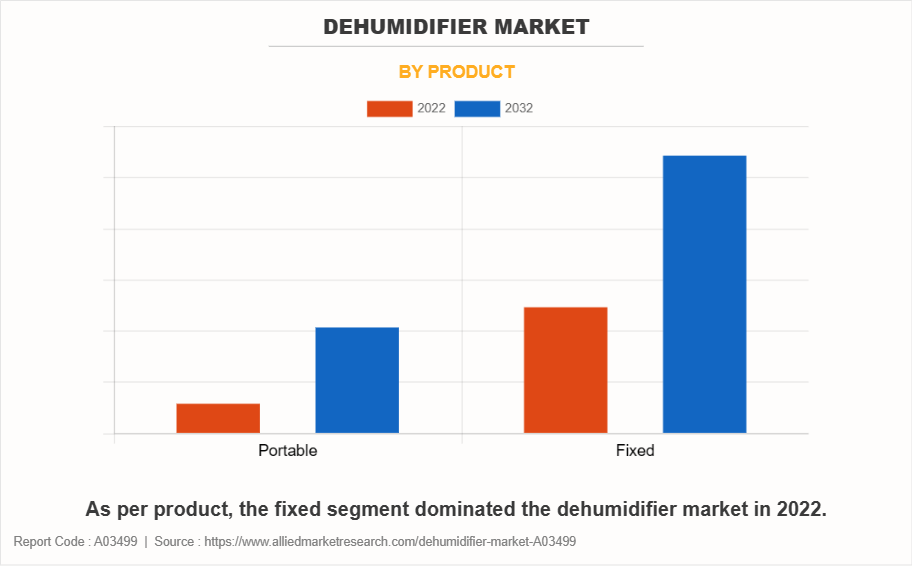
As per product, the fixed segment dominated the dehumidifier market in 2022 and is anticipated to maintain its dominance throughout the Dehumidifier Market Forecast period. The fixed dehumidifiers are HVAC (heating, ventilation, and air conditioning) systems which are made to regulate the relative humidity within a home or business. These dehumidifiers are incorporated into the ductwork or HVAC system of the structure and are permanently installed. Moreover, consumers now remotely manage & monitor humidity levels through smartphone apps owing to growth in integration of fixed dehumidifiers with smart home systems. The need for permanent dehumidifiers has increased due to factors such expansion of commercial applications, growing health and comfort concerns, growth in the construction industry, and retrofit projects. Opportunities include partnerships with HVAC and building automation companies, global market expansion, technological advancements, education and awareness campaigns, and customization to meet unique humidity control needs across a range of industries.
BY APPLICATION
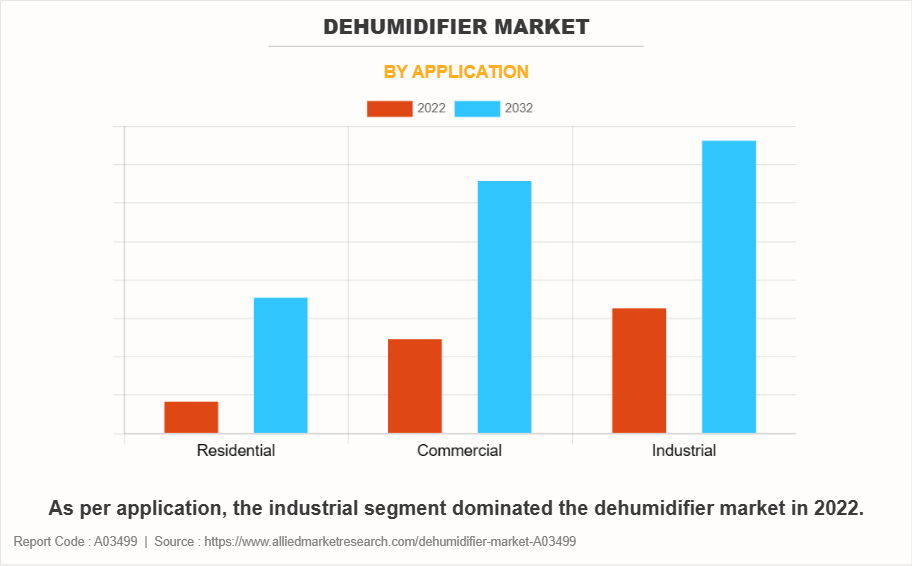
As per application, the industrial segment dominated the dehumidifier market in 2022 and is anticipated to maintain its dominance throughout the forecast period. High-capacity dehumidifiers are necessary in industrial applications since they frequently deal with complicated & difficult circumstances. The industrial establishment such as manufacturing facilities, food processing facilities, pharmaceutical & biotechnology facilities, cold storage & warehouses, aerospace & aviation industry, petrochemical & refinery industry, textile & paper mills, water treatment plants, and museums use dehumidifiers to regulate humidity levels. Dehumidifiers are used for a variety of purposes in the industrial sector for product drying, relative humidity control, and moisture removal. Segment growth has been propelled by the expansion of the manufacturing sector, warehouses, and water treatment facilities. Furthermore, the use of industrial dehumidifiers has surged due to the need for a safer & healthier work environment.
BY DISTRIBUTION CHANNEL
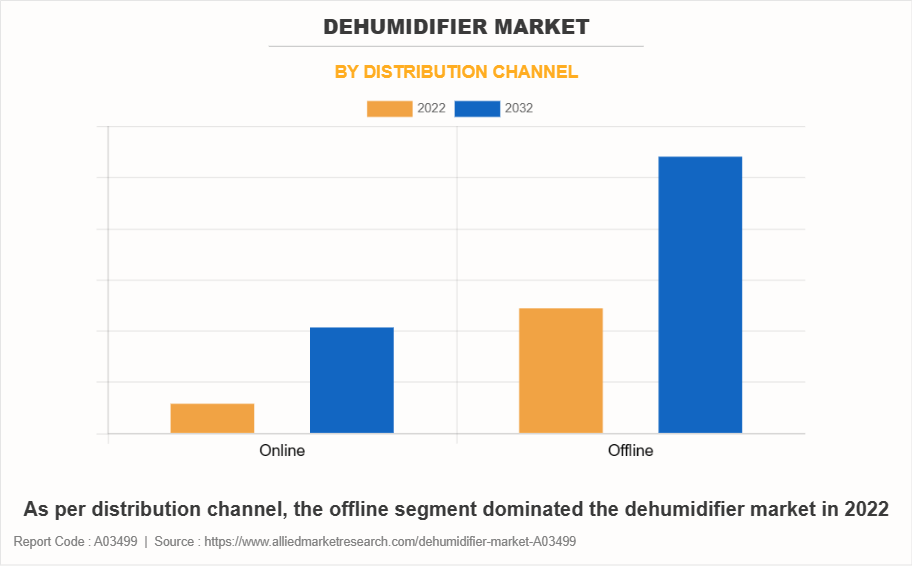
As per distribution channel, the offline segment dominated the dehumidifier market in 2022 and is anticipated to maintain its dominance throughout the forecast period. The appeal of offline retail stores is influenced by the opportunity for in-person product examination and individualized consultation with knowledgeable sales professionals. Customer satisfaction and trust have been further influenced by immediate gratification and after-sales services provided by the companies. Moreover, direct interaction with communities and potential customers has been made possible by trade show participation and local marketing initiatives. Initiatives for consumer education, product bundling, and geographic market expansion have created growth opportunities. Furthermore, partnerships with HVAC contractors and emphasis on sustainability have boosted sales and appealed to consumers concerned about the environment.
BY REGION
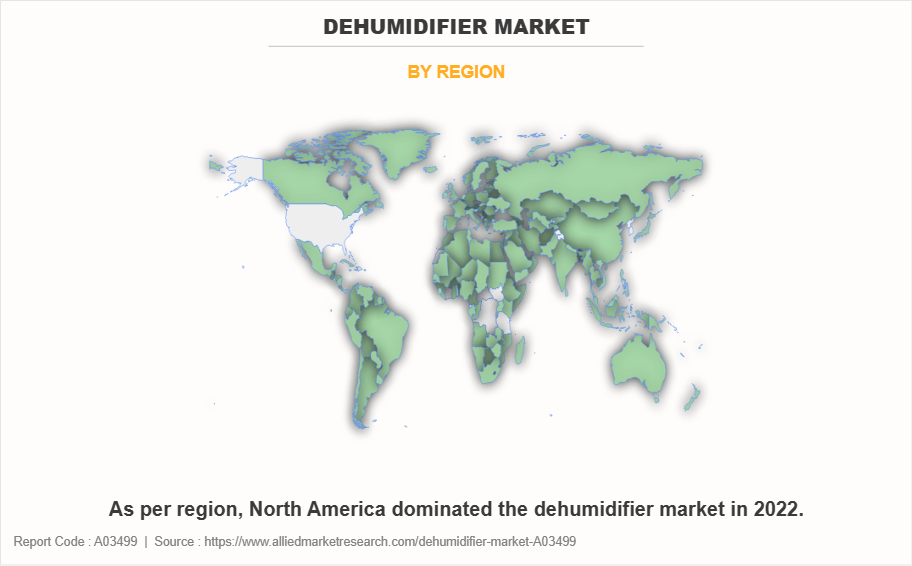
As per region, North America dominated the dehumidifier market in 2022 and is anticipated to maintain its dominance throughout the forecast period. The electrical appliance industry in North America is well-established, uniform, and has a high rate of product penetration. Product replacement drives most of the dehumidifier market. Numerous home appliances, including huge dehumidifiers can fit in large homes. There are numerous domestic & international manufacturers in the market. Major participants in this industry are LG Electronics, Haier, and Whirlpool. In the near future, the dehumidifier industry is expected to see prospects as a result of the continuous growth in the residential and industrial sectors.
COMPETITION ANALYSIS
The major players analyzed for the dehumidifier industry include LG Electronics Inc., Honeywell International Inc., Haier company, De’Longhi Appliances S.r.l., Whirlpool Corporation, Munters Group, CondAir Group, Bry-Air Inc., Stulz GmbH, Danby Products Ltd.
Manufacturers of dehumidifier market are creating new products and formulae to meet the change in requirements of their customers. They make investments in R&D to create novel combinations of ingredients with enhanced functionality, stability, and selectivity and create new applications for the dehumidifier market. Manufacturers of dehumidifiers are frequently working with innovative product producers, regulatory organizations, and other industry players for developing new products. Manufacturers are expected to increase their capacities, pool their knowledge, and create novel solutions through these collaborations.‐¯‐¯
Manufacturers have improved their production capacity and cost cutting, which are expected to involve both investing in new production facilities and renovating current ones to keep up with the rise in demand for dehumidifiers. Furthermore, manufacturers of dehumidifiers are anticipated to merge with or buy other businesses to broaden their product lines, get access to new markets or technologies, or do both at the same time. They are expected to benefit from merging and acquiring businesses by expanding their product lines, gaining a larger market share, and enhancing their economies of scale.‐¯‐¯‐¯
Key Benefits For Stakeholders
- This report provides a quantitative analysis of the market segments, current trends, estimations, and dynamics of the dehumidifier market analysis from 2022 to 2032 to identify the prevailing dehumidifier market opportunities.
- The market research is offered along with information related to key drivers, restraints, and opportunities.
- Porter's five forces analysis highlights the potency of buyers and suppliers to enable stakeholders make profit-oriented business decisions and strengthen their supplier-buyer network.
- In-depth analysis of the dehumidifier market segmentation assists to determine the prevailing market opportunities.
- Major countries in each region are mapped according to their revenue contribution to the global market.
- Market player positioning facilitates benchmarking and provides a clear understanding of the present position of the market players.
- The report includes the analysis of the regional as well as global dehumidifier market trends, key players, market segments, application areas, and market growth strategies.
Dehumidifier Market Report Highlights
| Aspects | Details |
| Market Size By 2032 | USD 4.7 billion |
| Growth Rate | CAGR of 6.6% |
| Forecast period | 2022 - 2032 |
| Report Pages | 288 |
| By Application |
|
| By Product |
|
| By Distribution Channel |
|
| By Region |
|
| Key Market Players | Haier Smart Home Co., Ltd., Munters Group AB, Honeywell International Inc., Condair Group AG, LG Electronics Inc., Stulz GmbH, Danby Products Limited, De'Longhi Appliances S.r.l., Bry-Air (Asia) Pvt. Ltd., Whirlpool Corporation |
Analyst Review
This section provides the opinions of top-level CXOs in the dehumidifier market. According to them, increase in demand is anticipated for dehumidifiers, and this trend may not change during the forecast period. The prices of dehumidifiers and their parts have increased significantly, as a result of rise in freight and raw material expenses. The dehumidifier market is anticipated to experience high-value growth as the economic condition of consumers gets better and more of them are inclining toward premium & stylish products, however, volume growth may be impacted as first-time buyers may deal with inflationary pressures.
Consumer electronic goods manufacturers reported that retail trade partners are stocking up more on dehumidifier and other electronic products in the mid to premium price range and are being concerned about doing the same on entry-level products. Moreover, the senior executives predicted that the industry as a whole is expected to expand in value beyond pre-pandemic levels. The mass market still struggles, while the premium and mid-level segments are doing significantly well after the pandemic.
Furthermore, increase in percentage of the population with access to electricity and rise in demand & rapid expansion of the industrial & commercial sector have significantly driven the dehumidifier market. Growth in demand for energy-efficient & eco-friendly dehumidifiers is expected to boost the market in terms of sales & overall growth. Thus, it is expected to see steady growth in the dehumidifier industry in the anticipated period.
The forecast period in the Dehumidifier market report is 2023 to 2032.
The fixed segment is the most influential segment in the Dehumidifier market report.
The market value of the Dehumidifier market in 2022 was $4,737.6 million.
North America holds the maximum market share of the Dehumidifier market.
The company profile has been selected on the basis of revenue, product offerings, and market penetration.
The global dehumidifier market was valued at $2,504.9 million in 2022, and is projected to reach $4,737.6 million by 2032, registering a CAGR of 6.6% from 2023 to 2032.
The major players analyzed for the dehumidifier industry include LG Electronics Inc., Honeywell International Inc., Haier company, De’Longhi Appliances S.r.l., Whirlpool Corporation, Munters Group, CondAir Group, Bry-Air Inc., Stulz GmbH, Danby Products Ltd.
The base year calculated in the Dehumidifier market report is 2022.
Loading Table Of Content...
Loading Research Methodology...



